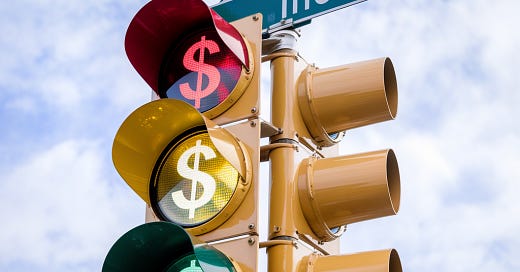If you’ve been staring at your increasing costs over the last few weeks and thinking that you’re going to have to take a price increase, you’re not alone. However, increasing price is almost always a fraught decision, and all the more so when many industries are still waiting to see if they get their “soft landing” of the economy or a slip into actual recession.
However, it’s important to remember that you seldom get credit for doing nothing — even if that “nothing” is not taking a price increase. While you may have difficulties with customers due to taking a price increase, they will seldom recognize your silent heroism on their behalf if you simply sit and absorb cost without passing it on. If you do choose not to take a price increase in a rising cost environment, it’s essential that you take credit for that. Make that inaction an action. I’ll cover this question at the end of today’s article, but first I’m going to address how to take a price increase.
How much to increase price
This very much deserves its own post, but since I’m talking about how to increase price, it seems logical to speak briefly about how much to increase price.
When you decide to take a price increase, you’re balancing between two factors: increasing your margins and not getting so far out of price position with your competitors that you lose significant sales.
If you’re taking a price increase because your costs have gone up, obviously any price increase will help to some extent. However, the risk is that you will often find yourself bargaining against yourself.
Increasing your prices can feel hard, and you naturally fear that your customers will be angry about it. As a result, you are often tempted to take a smaller increase than it would take to cover your cost increase, so that you’re “hurting” your customers as little as possible.
This is usually a bad instinct. If you’re taking your prices up at all, you’re exposing yourself to the possibility of a negative reaction. You should go ahead and take enough of a price increase to cover all of your cost increase, plus a little bit extra for safety.
That little bit extra is not greed. First of all, if costs have already gone up enough to force you to increase prices, it’s likely they may go up a bit more before they stop. This will give you some buffer before you need to increase prices again.
Additionally, you want to send both your customers and your competitors a clear signal as to how much costs have increased. If you take an increase which is not large enough to cover your cost increase, any competitors who are tracking your prices will conclude that “the market doesn’t allow us to cover all of this cost increase” and they may well follow your example in not increasing prices enough to cover the new costs. Pretty soon, your whole market segment has become less profitable to do business in.
Finally, it may be that you will have to give some customers a discount off the new, increased price. So by giving yourself a bit of extra room, you leave yourself some room to maneuver.
The easy price increase
If your product is something which people buy infrequently, and where your product has differentiation from your competitors, taking a modest price increase should be very easy for you. You really have very little excuse for not passing on your cost increases, and indeed for not increasing your margins gradually through pricing over time.
One mistake which we often make is to assume that customers know our products and their prices as well as we do. I’ve seen it take weeks for a brand team managing a consumer packaged good such as potting soil or insect killer to work up to the decision to increase price by 5% to 10%. The fact is that on a product which the customer only buys once every year or two, the customer has no recollection of what price the product was last time. If last year the price was $12.99 and this year it’s $13.99, the customer really will not know the difference.
If you have a close competitor which is not changing prices, this could be more of an issue. But if your brand was already the stronger and higher priced brand, you have some ability to lead the market and very few obstacles.
Even on a high ticket item like a piece of consumer electronics or a car, unless your price change is going to put you significantly out of position with competitors which your customers would consider as good as or better than you, taking an increase of a few percent should be doable. Again: you know what your price was last year, but your customer likely does not. They do not know that you took a price increase. They only know what your price is at the point in time when they go to look at your product. If your new price is not unreasonable in terms of value to the customer and price positions versus your competitors, you are not going to take heat for the change.
The medium price increase
A somewhat more difficult situation is when your product is something which the customer buys frequently, but which is nonetheless a small percentage of the customers total spending.
A famous recent example of this has been the price of eggs.
Eggs are not a major portion of a household’s total expenses, or even of a household’s total food expenses. However, they are something people buy frequently. So when avian flu sent egg prices up by over 100%, people noticed. And so it generated a lot of memes:
However, despite all the complaints, the increase in egg prices from around $2 per dozen to more than $5 per dozen didn’t actually put eggs financially out of people’s reach. Indeed, even with high egg prices, consumer demand did not drop as much as egg production had, and it was common to see empty shelves despite the high price tags on them.
Because eggs are a frequent purchase, people notice when the price goes up. They remember how much it cost the last time they bought. But while it’s frustrating to pay so much for a staple food item, in truth seeing your weekly grocery bill go up by $3 to $6 isn’t going to affect your family economy that much. Since people are attached to their eggs (it’s famously hard to make an omelet — or many kinds of baked goods — without breaking a few) they will tend to go ahead and buy them even at a price that makes them annoyed.
In this kind of situation, it’s essential that you provide communication about your price change and the reason for it, because customers will notice it. This applies not just to a consumption product like eggs, but also to any number of other regular expenses such as a monthly Spotify subscription.
If you are changing the price of a product which customers buy regularly (or subscribe to) you should make an effort to communicate why your prices are changing. It doesn’t need to be super detailed.
If you’re emailing your subscribers about the price of a service subscription going up, the explanation might be a paragraph or two talking about how you continue to value them and strive to provide the best service possible. If you’re raising the price of eggs, communication might be both news stories put out by egg producers and also signage put up by grocery stores.
In this kind of situation, where customers are very much going to notice any price increase, it’s tempting to either not take a price increase at all, or to argue yourself down and take a smaller increase than costs would indicate. Indeed, this is what many grocery stores did with eggs. The national average wholesale price for eggs exceeded $8 per dozen during February, yet many stores were still selling eggs in the $5 to $6 range.
If you make that kind of sacrifice, you should be shouting it from the rooftops. But more often, you should just take the necessary price increase. After all, while visible, the price increase is still a small percentage of the customer’s total spending. They can afford the change.
The hard price increase
That is what distinguishes the hardest type of price increase: the one in which the price is highly visible to the customer and your product is a major portion of your customer’s expenses.
How you navigate this is going to depend very much on the margin structure of your business and the customs of your industry.
If you have a highly commoditized business and your margins are low (picture a steel mill or an agricultural commodity) you will want to communicate your costs very clearly to your customers and indeed have cost-index-based agreements which define how your prices will change seamlessly as your costs change.
If you have a much more specialized business with higher margins, such as producing the machinery that goes into oil field production or high speed manufacturing lines, your customers rely on your products having very predictable pricing. In that kind of situation, you may need to provide significant warning to you customers before you can increase prices.
Either way, clear communication of why you are taking price changes is very important. You don’t need to tell your customers everything about how your business and your costs work. But you do need to provide a clear explanation of why your prices are changing and when.
Taking credit for not increasing prices
By now you’ve surely noticed that communication is a theme when it comes to pricing. Good pricing involves good communication.
This applies just as much if you are making a strategic decision not to increase prices despite an increase in cost.
Maybe you have been able to find other ways to increase efficiency and offset the cost increases. Or maybe you’ve decided that it’s important for you to accept lower margins rather than hitting your customer with a price increase.
Either way, the only way to get credit for this price increase is for customers to see it.
If all of your competitors have increased their prices, but you are choosing to keep your prices the same, it’s at least moderately obvious. Even so, you might want to emphasize the point.
For instance, I’m responsible for managing the annual Mulch Sale which my son’s boy scout troop does as a fund raiser. They buy bagged mulch at the lowest prices of the season and deliver it to people’s homes for $5/bag.
That’s a threshold price point, and also a pretty significant markup. So we’ve chosen not to increase the price even though we’re not sure we’ll be able to source the mulch quite as cheaply this year. But when I sent out the email to our past customers, I made sure to say, “With so many prices changing, the price of our Boy Scout Mulch is still the same as it’s been since 2018.”
People know that our delivered mulch is more expensive than it would be to pick it up at the store, but by emphasizing that we’re keeping prices the same as they’ve been since before COVID we can communicate a commitment to value even with those high prices.
If you find yourself holding your prices even as your costs go up (even if you’ve found a way to cover that through efficiency) make sure that you tell your customers you’re looking out for them by keeping those prices flat. They can’t value what you don’t tell them.








